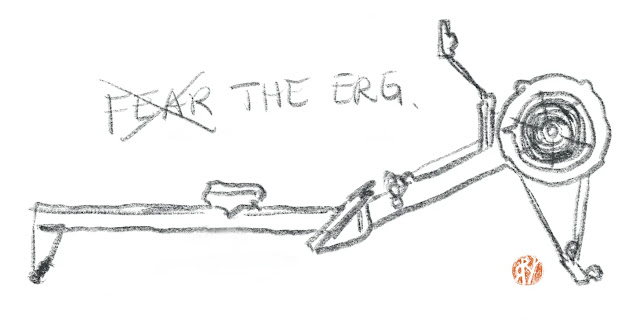Coaches' Corner: Finish and Release
The release (where the outside hand taps the handle down causing the blade to exit the water on the square) is the most important position to master first because it is the key to initiating a good recovery and, therefore, a good catch.
 |
| Cal women's rowing training in Seattle (Photo: B. Kitch for Rowing News) |
It is important that posture is maintained as the handle is drawn through the finish (if the body slumps down into the boat, the rower cannot possibly maintain pressure on the handle as the support structure for the work of the arms lies in the static strength of the core), so the first step is to make sure that your athletes are sitting up tall, which requires development of the core musculature.
The next item to focus on is the position of the hands.
The next item to focus on is the position of the hands.
The handle should be drawn to the top of the rib cage, at which point the rower presses downwards with the outside hand, making a vertical turn (a 90 degree angle change in the trajectory of the handle), to a point where the rower will have clearance to allow the blade to exit on the square. This cannot be accomplished if the rower is slumped over the handle at the finish, as he or she will not have enough room to make the proper motion.
Typical problems that arise from having a curved spine at the finish are hunched shoulders and messy finishes. If the spine is curved, the shoulders will naturally elevate in an attempt to preserve proper handle height through the finish. Too much layback can prevent proper movement of the hands at the release, as the hands must be able to press the handle down, which is impossible if the body is underneath the handle at the release. Drills such as square blade rowing and outside-arm-only can help to correct issues at the release, but there are also ways to work on these issues indoors.
Six ways to work on the release on land:
1. Erging in front of a mirror
Take notice of your posture as you draw the handle through to the finish. Are you sitting up tall? Have you drawn the handle straight through the drive (a flat plane of motion) to the top of the rib cage? Are your elbows lined up with your wrists at the finish?2. Medicine ball twists
Sit on the floor and grab a medicine ball. Lift your legs off the floor and position your body such that you are sitting only on your 'glutes' (butt), and hold the ball just out in front of your body. Twist from side to side, just letting the ball tap the floor as you rotate each direction. This can be made more difficult by extending your arms.3. Sculler's sit-ups
This should be familiar to every rower. Sit in the same position as the medicine ball twist, with your body weight supported on your hind quarters. Begin with your knees tucked to your chest, and your arms outstretched. Finish with your arms drawn in at your body, and your legs fully extended straight forward from your hips. Shoulders, hips, knees, and ankles should all be aligned.4. Stair Jumps
Grab that medicine ball again. Find a suitable set of steps, and begin with hopping up two steps at a time (skip one step) while holding the medicine ball just out in front of your body with both hands, jumping off both legs (to imitate the legs during the rowing stroke). You can divide this workout into timed intervals or sets, depending on how many people are participating. As you get more advanced, jump up three steps (skip two), or four (skip three), if you are feeling ambitious. As you jump, make sure that your continue to hold the ball slightly away from your torso (hugging the medicine ball will not have nearly the effect on the core that holding it out will).5. Planks
Yeah, they're boring. And they make your elbows hurt (at least, if you're bony like me). But they get the job done. Front planks, side planks. The interval is up to you and how athletic the participants are. Make sure that your back remains straight ('neutral'), rather than allowing it to bow or peak.6. Two-footed jumps
The same principle as the stair jumps, but without the stairs. This time you can ditch the medicine ball too. Standing flat-footed, simply jump off both legs and tuck your knees as close to your chest as possible, taking care to land very softly on ball of your feet on the way down (landing on your heels is not acceptable, as it will simply have the effect of pounding your knees and hips). The idea is to jump off the legs, then use the core to pull the legs up as high as possible before returning to earth. This, coupled with a soft, quiet landing teaches a dynamic shove with the legs and an aggressive acceleration with the core, as well as a careful approach on the recovery. Best of all, it requires almost no space and no equipment.BEWARE, however, as silent landings are the key to injury prevention. Don't hammer, and perform this exercise on a softer surface, such as grass.
These can be coupled with 'superman' exercises (lie flat on your stomach, then lift your shoulders, arms, legs and head off the ground for 1-3 seconds, and repeat) to work both the front and back of the core musculature.
-RR
These can be coupled with 'superman' exercises (lie flat on your stomach, then lift your shoulders, arms, legs and head off the ground for 1-3 seconds, and repeat) to work both the front and back of the core musculature.
-RR



